After reading a bzillion threads on this, I have yet to get a definitive answer on this question.
"How do you get superior cover for hiding in combat?"
Let's first quote the relevant rules:
During a stealth check, the opponent is the one trying to determine if you have cover. Therefore the opponent picks one of its corners and draws imaginary lines to all 4 of your corners. If 3+ lines pass through an obstacle or one of its enemies (i.e. your ally), you have Superior Cover, and therefore can attempt a Steath check.
This can happen in combat if you position yourself correctly. For example, lets say Elly the Ranger is trying to hide from a goblin, behind 2 of her fighter allies:

(blue square is the goblin, green square is Elly, red lines are blocked, green lines are unblocked)
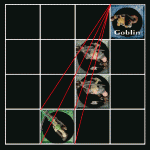
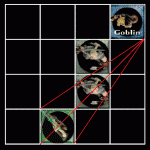
It's pretty obvious that no matter what corner the goblin picks, all 4 lines will intersect with one its enemies (i.e. Elly's fighter allies). Therefore Elly has superior cover and can attempt a hide.
Now if we remove one of the fighters, then Elly is in trouble:
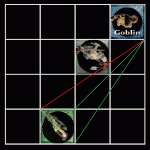
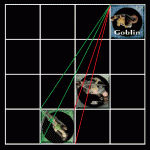
There are only 1-2 blocked lines in this case, and Elly only gets Standard Cover and can't hide.
But since, the requirement is only 3+ blocked lines, Elly can stick right behind her fighter ally and get back her Superior Cover.
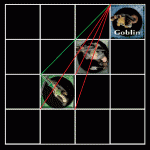
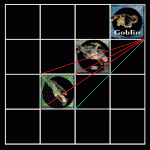
The rest of this thread centers around what happens after Elly succeeds the stealth check. It was concluded that the above situations would only allow Elly to make a stealth check, but in order to stay hidden, she must meet the requirement:
Therefore, when Elly attempts her hide check, the green square which she is standing on must have some concealment. Or, she must be under the effect of a power that grants her concealment.
If she doesn’t have concealment, she can still remain hidden if we replace one of the fighters with a statue. (Note: for this example, the statues will be treated as a pillar rather than a wall. This means that the statue corners do not block lines.)
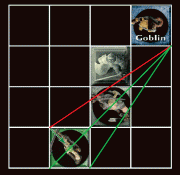

As you can see, the statue in each case blocks at least one line. Therefore, Elly gets cover from it and can remain hidden.
In the following case with only the statue, Elly can use the statue to both become and remain hidden.

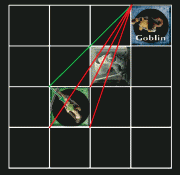
Those cases, with the statue replacing an ally, should have been fairly obvious. However, the interesting cases happens when you put the statue beside Elly.
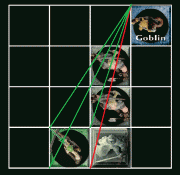

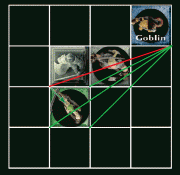
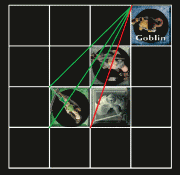
As you can see, the presence of a statue, will always block at least one line, providing cover for Elly to remain hidden.
So for DMs and players that want a clear WAR application of stealth and allies:
You can use your allies as superior cover to become hidden, but you simultaneously need concealment or a non-ally source of cover to stay hidden.
(Note: this works for the monsters as well.)
===
Comments on the RAI:
I believe it makes sense that allies can be used as a momentary source of cover for a stealthy character slip into a shadow or behind an obstacle. However, when hidden, that stealthy character can`t simply walk from ally to ally, treating them like obstacles for cover. Hence the restriction on ally-cover while hidden.
I also think this mechanic adds tactical depth, provides stealthy characters many more opportunies to actually use stealth in combat, and encourages party teamwork and cooperation. All of this, I believe makes for a more positive game experience.
But obviously, this is only my opinion. But at least, according to the RAW, this is how the stealth mechanic works. You must decide if that is what you want at your table.
Good gaming, everyone!
"How do you get superior cover for hiding in combat?"
Let's first quote the relevant rules:
PH2(p222): "You can make a Stealth check against an enemy only if you have superior cover or total concealment against the enemy or if you’re outside the enemy’s line of sight."
PH(p280): "Determining Cover: To determine if a target has cover, choose a corner of a square you occupy (or a corner of your attack’s origin square) and trace imaginary lines from that corner to every corner of any one square the target occupies. If one or two of those lines are blocked by an obstacle or an enemy, the target has cover. (A line isn’t blocked if it runs along the edge of an obstacle’s or an enemy’s square.) If three or four of those lines are blocked but you have line of effect, the target has superior cover."
During a stealth check, the opponent is the one trying to determine if you have cover. Therefore the opponent picks one of its corners and draws imaginary lines to all 4 of your corners. If 3+ lines pass through an obstacle or one of its enemies (i.e. your ally), you have Superior Cover, and therefore can attempt a Steath check.
This can happen in combat if you position yourself correctly. For example, lets say Elly the Ranger is trying to hide from a goblin, behind 2 of her fighter allies:

(blue square is the goblin, green square is Elly, red lines are blocked, green lines are unblocked)


It's pretty obvious that no matter what corner the goblin picks, all 4 lines will intersect with one its enemies (i.e. Elly's fighter allies). Therefore Elly has superior cover and can attempt a hide.
Now if we remove one of the fighters, then Elly is in trouble:


There are only 1-2 blocked lines in this case, and Elly only gets Standard Cover and can't hide.
But since, the requirement is only 3+ blocked lines, Elly can stick right behind her fighter ally and get back her Superior Cover.


The rest of this thread centers around what happens after Elly succeeds the stealth check. It was concluded that the above situations would only allow Elly to make a stealth check, but in order to stay hidden, she must meet the requirement:
PH2(p222): "Keep Out of Sight: If you no longer have any cover or concealment against an enemy, you don’t remain hidden from that enemy. You don’t need superior cover, total concealment, or to stay outside line of sight, but you do need some degree of cover or concealment to remain hidden. You can’t use another creature as cover to remain hidden."
Therefore, when Elly attempts her hide check, the green square which she is standing on must have some concealment. Or, she must be under the effect of a power that grants her concealment.
If she doesn’t have concealment, she can still remain hidden if we replace one of the fighters with a statue. (Note: for this example, the statues will be treated as a pillar rather than a wall. This means that the statue corners do not block lines.)


As you can see, the statue in each case blocks at least one line. Therefore, Elly gets cover from it and can remain hidden.
In the following case with only the statue, Elly can use the statue to both become and remain hidden.


Those cases, with the statue replacing an ally, should have been fairly obvious. However, the interesting cases happens when you put the statue beside Elly.




As you can see, the presence of a statue, will always block at least one line, providing cover for Elly to remain hidden.
So for DMs and players that want a clear WAR application of stealth and allies:
You can use your allies as superior cover to become hidden, but you simultaneously need concealment or a non-ally source of cover to stay hidden.
(Note: this works for the monsters as well.)
===
Comments on the RAI:
I believe it makes sense that allies can be used as a momentary source of cover for a stealthy character slip into a shadow or behind an obstacle. However, when hidden, that stealthy character can`t simply walk from ally to ally, treating them like obstacles for cover. Hence the restriction on ally-cover while hidden.
I also think this mechanic adds tactical depth, provides stealthy characters many more opportunies to actually use stealth in combat, and encourages party teamwork and cooperation. All of this, I believe makes for a more positive game experience.
But obviously, this is only my opinion. But at least, according to the RAW, this is how the stealth mechanic works. You must decide if that is what you want at your table.
Good gaming, everyone!
Last edited:
